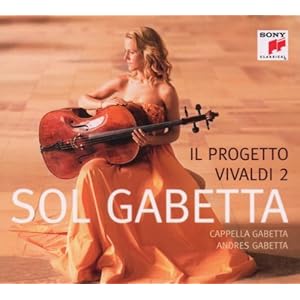Sol Gabetta Performs Italian Baroque Cello Concertos
 Although he is best known for his vast work of violin concertos, Antonio Vivaldi also wrote at least twenty-seven concertos for cello. These date from the time when he was working as composer of instrumental music for the orchestra of the girls' orphanage Ospedale della Pietà in Venice. Argentinean cellist Sol Gabetta already recorded five of Vivaldi's cello concertos in 2007. Her latest CD, Il Progetto Vivaldi 2, features three more, played on a valuable instrument built in Naples in 1781 by Ferdinando Gagliano. She is accompanied by the Cappella Gabetta, which she founded together with her brother, violinist and conductor Andres Gabetta. The Baroque ensemble consists of hand-picked Early Music specialists she is friends with, taken from groups like the Basel Chamber Orchestra, the Orchestre Baroque de Limoges and Il Giardino Armonico. In addition to a sonata from the pen of "the red-haired priest", as Vivaldi was known, the new release also contains two concertos by contemporaries of his – one of them the world première recording of the cello concerto by Giovanni Battista Platti (1697–1763). Il Progetto Vivaldi 2 is available Tuesday, September 27, 2011
Although he is best known for his vast work of violin concertos, Antonio Vivaldi also wrote at least twenty-seven concertos for cello. These date from the time when he was working as composer of instrumental music for the orchestra of the girls' orphanage Ospedale della Pietà in Venice. Argentinean cellist Sol Gabetta already recorded five of Vivaldi's cello concertos in 2007. Her latest CD, Il Progetto Vivaldi 2, features three more, played on a valuable instrument built in Naples in 1781 by Ferdinando Gagliano. She is accompanied by the Cappella Gabetta, which she founded together with her brother, violinist and conductor Andres Gabetta. The Baroque ensemble consists of hand-picked Early Music specialists she is friends with, taken from groups like the Basel Chamber Orchestra, the Orchestre Baroque de Limoges and Il Giardino Armonico. In addition to a sonata from the pen of "the red-haired priest", as Vivaldi was known, the new release also contains two concertos by contemporaries of his – one of them the world première recording of the cello concerto by Giovanni Battista Platti (1697–1763). Il Progetto Vivaldi 2 is available Tuesday, September 27, 2011
The works on the recording combine virtuoso demands and brisk tempi with charming cantilenas. They also show how quickly the works of the Italian Baroque masters became popular at German royal courts. One of the most important amateur musicians in the first half of the 18th century was the German Count Rudolf Franz Erwein von Schönborn (1677-1754). Schönborn was an outstanding cellist, who met Corelli while a student in Rome. He also built up a unique music library at his palace Schloss Wiesentheid in Franconia, the foundation of which the diplomat-to-be assembled in Rome.
Except for the five-movement concerto by the Neapolitan composer Leonardo Leo (1694 - 1744), all the works on this CD come from the Schönborn collection. Giovanni Battista Platti wrote his D minor cello concerto for the Count; it displays particularly sophisticated composing technique in the concertante and fugal outer movements, and cantabile and expressive melodies for the solo instrument in the slow movement. Vivaldi's G minor cello sonata is another rarity: the sarabande theme in the third movement bears an astonishing resemblance to the sarabande in J.S. Bach's second suite for solo cello.

Comments